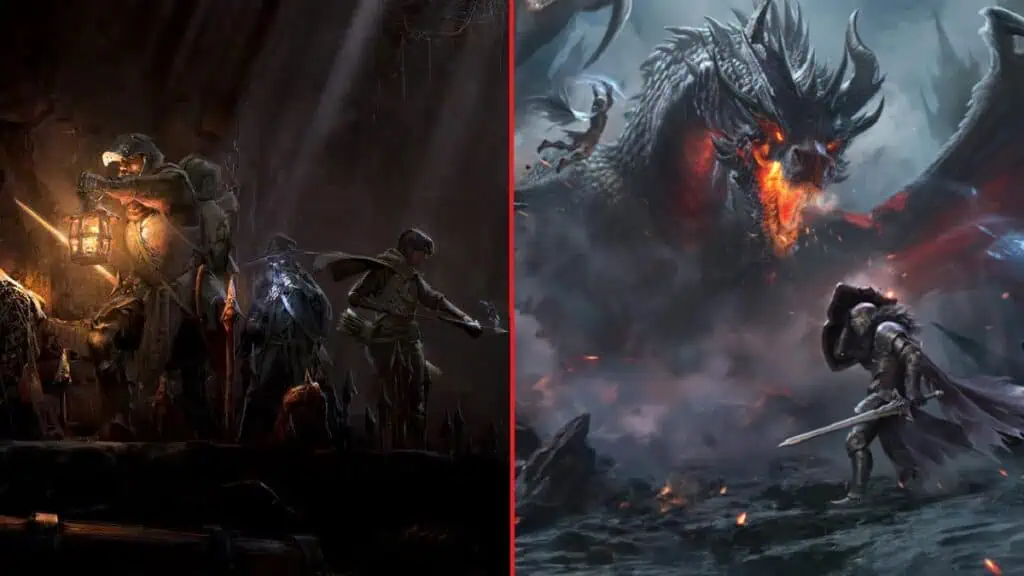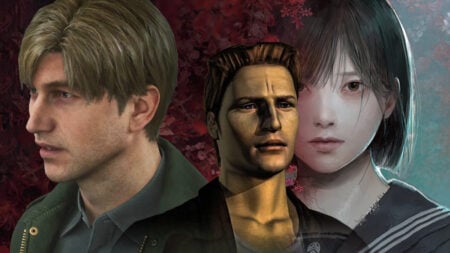Skip To...
For the first couple minutes, I had to remind myself I was playing Dungeonborne and not Dark and Darker. The similarities are hard to ignore at first, like the dark, dreary dungeons and its hybrid PvPvE gameplay. Once you get into the combat though, and the classes overall, that’s where the schism starts. While Dungeonborne and Dark and Darker are cut from the same cloth, there are several noticeable differences that could sway you to play one over the other.
Combat: Dungeonborne vs Dark and Darker

After a couple matches of Dark and Darker, you’ll quickly realize the game moves at a snail’s pace, only feeling bursts of speed when you’re under the influence of buffs or abilities. Dungeonborne, on the other hand, feels much faster, from the animations of the weapons swinging to movement. You won’t feel like you’re moving through molasses.
Spells and abilities are also implemented differently. Dark and Darker tends to limit the number of times you can cast spells—not so in Dungeonborne. Instead, you have a mana bar, which can be restored with potions or, in some cases, another type of resource like the death knight and cryomancer’s soul energy.
When you step back and look at both as a whole, Dark and Darker feels much more methodical, while Dungeonborne is more chaotic. If you make a mistake in Dungeonborne, like getting hit with a well-aimed spell, the enemy group will quickly collapse on you. In Dark and Darker, it’s easier to come back from a mistake with smart positioning and tactile maneuvers.
Classes, Abilities, and Passives

Taking a look at classes, abilities, and passives, Dark and Darker has a much better customization system, and it’s primarily how the game handles passives and abilities. Not to mention Dark and Darker has nine classes as opposed to eight, and each class has more abilities in their kit on average.
In both games, all skills and spells are unlocked from the start. However, Dungeonborne limits you to only two skills, hotkeyed to Q and E. Furthermore, you can only equip certain skills to each key. For example, as a fighter, you couldn’t equip Whirlwind and Battle Cry because they both occupy Q.
Both games also have passives—Dark and Darker calls them perks. The defining difference between the two is that Dark and Darker lets you choose four perks; Dungeonborne gates off passives if you don’t reach specific stat requirements. If I wanted the Fired Up passive on my fighter in Dungeonborne, I’d need to increase my strength stat to 87.
On the flip side, Dungeonborne doesn’t limit the number of passives you have. Using my fighter as an example again, if I were to unlock the Fired Up passive, I’d also unlock the Hamstring passive in the process because Hamstring only requires 50 strength. Every class has five passives and with the right gear, you could potentially unlock all five.
Game Modes: Dungeonborne vs Dark and Darker

Dungeonborne is hands down the clear winner when it comes to game modes. It doesn’t have just one, but essentially three game modes to play. Dark and Darker is just the same game mode with different maps and a choice between normal and high-roller.
In Dungeonborne, there’s Clouseau Castle and Sinner’s End, which is nearly identical to Dark and Darker’s one and only game mode. The main difference is that Sinner’s End has boundaries that close in on you over time. There’s also the Mithril Order, training room, custom games, and team deathmatch.
The training room is a real dealbreaker for me. It’s a huge waste of time to try new weapons and skills in Dark and Darker. I’d have to queue into a match, equipped with the gear and skills I want, to test them live. You run the risk of dying and losing the weapon (and gear) for good.
There’s even a Challenger Mode in Dungeonborne, mixing solo and groups together as opposed to having their own queues.
Dark and Darker vs Dungeonborne: Who Wins?

Personally, I can see myself playing both, but if I had to choose, I’d go with Dark and Darker. What it comes down to for me is class diversity. Sure, having a few more game modes is awesome, but that’s not enough if it means having fewer options for classes.
Part of the fun of Dark and Darker is that just about every class has multiple builds, for both solo and group players. Unless you’re a bard, in which case you’re only really useful in groups (I mean that in the nicest way possible; I love bards).
Combat is also a major point in Dark and Darker’s favor. Yes, it is slower than Dungeonborne by comparison, but that slower speed leaves more room for strategizing as opposed to winning a duel because you can mash buttons faster.
With that said, Dungeonborne is definitely more beginner-friendly, thanks to the training room, the Mithril Order, and Heirloom gear. The Mithril order is a game mode that has you using throwaway characters to get gear. Upon escaping, that gear can then be used to craft Heirloom gear. It’s a fantastic way to equip your main characters with decent gear rather than risking it all.







